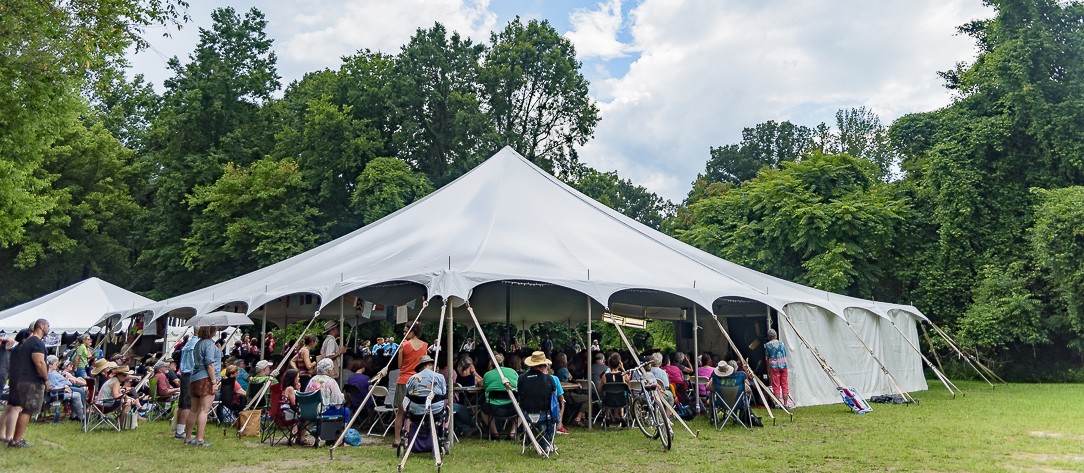Nestled within the lush bosom of North Carolina’s Pisgah National Forest lay the open fields of the Hot Springs Resort and Spa campground. Surrounded by mountains and bordered by the French Broad River, this inconspicuous little spot envelops all who sojourn there in the deep peace that comes with pristine nature — and the near total loss of cell service.
No matter from whence a sojourner comes, the journey demands a certain kind of stamina, one that can withstand losing GPS signals multiple times and doesn’t succumb to motion sickness easily. Such are the attendees of the annual Wild Goose Festival, an event in which progressive Christians flock to the remote locale for four days of Burning Man meets SXSW.
“The Goose,” as it’s called by the faithful, has been gathering since 2010, each year hosting hundreds of sessions geared around the central topics of Spirit, justice, music and art. Speakers like Nadia Bolz-Weber, William Barber and Brian McLaren have headlined the event, but you won’t just see these big names on the mainstage or tucked away in inaccessible green rooms. The informality of the space invites casual contact.

(Photo courtesy of Wild Goose Festival)
Most of the participants camp within the venue itself, and there’s something about walking on dusty paths in the sweltering humidity of a Southern summer that breaks down the typical, if informal, barriers erected to protect session speakers from common folk at more polished conferences. Add in all the little kids darting in and out of the white-topped tents, and it’s obvious why so many people say the festival feels like a family reunion.
But this family reunion has some glaring absences.
White Goose
Despite intentionally seeking out persons of color to be keynotes and to serve as board members, the Goose suffers from the ailment all too common to many progressive Christian spaces — overwhelming whiteness.
In fairness, perhaps 2021 is not the best year in which to judge its demographics. “This was probably the oldest and whitest festival we’ve ever had,” said Joy Wallis, chair of the board. Overall attendance was down this year due to the pandemic, the subsequent vaccine requirement, the date change. Usually the festival happens in the middle of summer break, but this year it began on the Wednesday before Labor Day, meaning a whole contingency of students and young families couldn’t attend.

(Photo courtesy of Wild Goose Festival)
But even without the extenuating and special circumstances of this year, the Goose’s whiteness has led some to redub the Wild Goose festival “White Goose.”
Exposing and criticizing the whiteness of C suites, governments, churches and movements has become something of a cottage industry in the last few years, and the Goose always has attracted this kind of attention. “I’m happy it doesn’t go away,” Wallis said of the racial scrutiny, “because it shouldn’t.”
Location, location, location
The major issue is the festival’s location. First, there’s the sheer inaccessibility. Rural paradises don’t usually have a major airport nearby, and Hot Springs is no exception. That means attendees must either live within driving distance or fly to Asheville or Knoxville and then rent a car. There’s no Uber out here, just expense upon expense. Geographic inaccessibility tends to equal financial inaccessibility.
Then there’s the overt hostility. As in many rural Southern areas, Western North Carolina hosts an unfortunately impressive amount of Confederate flags, and in recent years, Trump flags. Driving on winding mountain roads, where cellphone coverage is intermittent at best and gas stations increasingly sparse, becomes a Get Out sequel waiting to happen if you get lost or run out of fuel. Wallis acknowledges these obstacles, saying Hot Springs “is not an optimal place until you get there. It can be a bit scary getting there.”
But even after arrival, the threat of violence still looms.
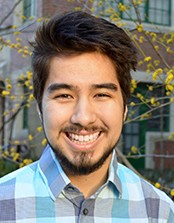
Kenji Kuramitsu
Kenji Kuramitsu, a Japanese American man who volunteered with the Goose’s creative team in 2015 and 2016, remembers spotting a huge Confederate flag waving outside a home just a stone’s throw from the campgrounds. “I don’t think it was up before the festival started, and I think they put it up after it began, if memory serves,” Kuramitsu recalled. At some point that evening, someone from the festival went and tore the flag down.
However, the next day it had been replaced with a swastika flag.
“You can’t just order that from Amazon and have it delivered in 12 hours,” Kuramitsu said, pointing out, “they had that ready to go.” The following day Kuramitsu accompanied another attendee on a quest to take down the Nazi symbol, no small act of courage for two men of color to undertake in Western North Carolina. But someone else had gotten there first — and burned the flag. The identity of this vigilante is unknown, but Kuramitsu wagers it was a white attendee, noting, “I respect what they did.”
Destroying a hate symbol is certainly praiseworthy. And, at least that year, the festival provided security and escorts to ensure people’s safety in the town. However, individual acts of white allyship can achieve only so much in an environment saturated in overt white supremacy, and, in some ways, may even stall us from zeroing in on the core issue: How much courage, vigilance and resilience is required of persons of color just to attend this festival.
And while it should be noted that white attendees also have been harassed by neo-Nazis cruising in Hot Springs, the reality is that verbal abuse is much more likely to escalate into physical violence when the target is a person of color. Kuramitsu explained, “Some of us carried a heightened awareness of that that others did not.”
Possible solutions
In light of these experiences and other complaints, the board for years has been tossing around the idea of a second conference. To make the Goose more accessible and safer for persons of color, this second festival would take place in or near a major city like Atlanta, Detroit or Chicago. This solution, undoubtedly imagined with the best intentions, nonetheless feels suspiciously like another iteration of “separate but equal,” especially when contrasting the demographics of Hot Springs with the aforementioned cities.
So why not just change the original festival’s venue?
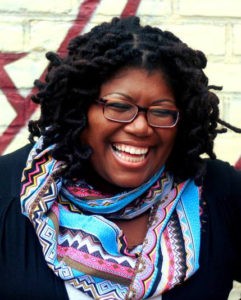
Alicia T. Crosby
“I think it would fundamentally alter the culture of the festival, how it’s been so far,” said Mike Morrell, a founding member of the Goose. But “how it’s been so far” has sort of operated like a zero-sum game. Alicia T. Crosby, a queer Black woman and former youth director for the Goose, explained, “It’s about whose comfort, whose desires, are you prioritizing? And what does that mean for the safety and accessibility of other people?”
Crosby’s juxtapositions here reveal something crucial — the comfort and desires of one group are, to a degree, inversely related to the safety and accessibility of another group. In the case of Wild Goose, that means changes and accommodations made for the benefit of persons of color can only go as far as white attendees’ comfort is maintained.
This is white supremacy at work.
The call is coming from inside the house
Some may say that’s an overly harsh judgment, but these pearl-clutching dismissals usually stem from a misunderstanding of what white supremacy actually is. It’s easy enough to spot in a Confederate flag or in the slurs hurled from skinheads in moving cars. These are the sharks from Kyle “Guante” Tran Myhre’s viral poem “How to Explain White Supremacy to a White Supremacist” — obvious threats that any reasonable person sees as morally wrong. However, as Myhre said, “white supremacy is not a shark; it’s the water” (emphasis added).
Like water is for fish, white supremacy is undetectable, all-encompassing and utterly normal to the point of invisibility in U.S. culture. It is our culture. Christianity has a long history of being co-opted by white supremacy in this country, a legacy that still continues today even in progressive justice-oriented spaces. Including, but certainly not limited to, Wild Goose.
But that’s not to say they aren’t aware of it. According to their statement on faith-based justice:
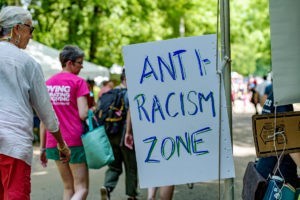
(Photo courtesy of Wild Goose Festival)
We are rooted in Progressive Christianity. For us this means moving beyond belief to center ourselves in justice and compassion, to walk toward those in need and to solidarity with the marginalized and the oppressed, acknowledging our own privilege and actively working to use our power to alleviate suffering and achieve wholeness.
We take seriously the trauma and evil that has been done and is being inflicted upon our neighbors who are vulnerable — based on race, religion, identity, class and other differences. We also take seriously the struggle of the privileged and powerful to fully grasp the reality of this trauma and evil. Knowing that absolutely safe space is impossible, we seek to create brave space where we can enter into needed conversations for mutual liberation.
12 steps to recovery?
Kuramitsu initiated one of those “needed conversations” in 2016 when he sent the festival’s leadership a letter. In a strikingly gracious tone, he offered 12 concrete suggestions for the Goose to begin making itself more accessible and hospitable to persons of color.
The adoption of some ideas like inviting more non-white-oriented musical acts, continuing the pre-festival Justice Camp, and directing more funds to both persons of color as speakers and attendees indicates the leadership’s intent to “walk toward those in need and to solidarity with the marginalized and the oppressed,” the organization’s website says.
Have these steps been enough? Well, no. To many, they feel like hollow gestures, or a “pantomime of inclusion,” as Crosby has put it.
What if all 12 of Kuramitsu’s suggestions were implemented? Would that then be enough?
Again, the answer is no. That’s because asking what qualifies as enough is the wrong question. It is the kind of question the powerful ask when they’re looking to reform their power structure without destroying it or losing their own place within it. And this is why the festival’s leadership continues to miss the mark.
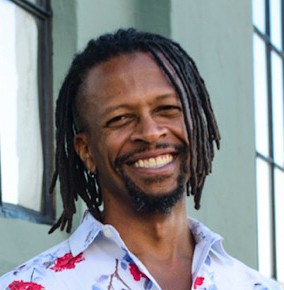
Adam Lawrence Dyer
“You can’t task white supremacy with dismantling itself without reinforcing white supremacy,” explained Adam Lawrence Dyer, an African American Unitarian Universalist minister serving on the Goose’s board. “There needs to be a deeper, more foundational shift, before we can think about things like this,” he continued, referring to Kuramitsu’s list.
That deeper, more foundational shift first requires a look back.
Original sin
“We never were a group that decided that we wanted to welcome LGBT people, although we did. We were LGBT people. It wasn’t like we were trying to bring them in to make us more diverse,” said Wallis, reflecting on how the origins of the festival — and identities of the founders — manifested a specific kind of diversity.
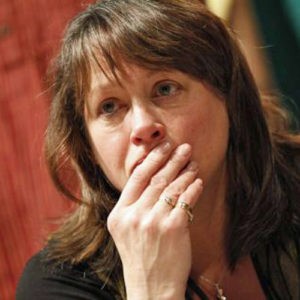
Joy Wallis was one of the first women ordained to the priesthood in the Church of England in 1994. She was the real-life Vicar of Dibley and the inspiration for the 1994 BBC comedy series of the same name. (Photo: Wild Goose Festival)
“The festival has grown up being a place that was created by that diversity. So that’s the bottom line that I think is very important to understand — that was a natural diversity. That was embraced right from the beginning, which is why it is so strong now. (LGBTQ) People don’t feel like they are being patronized or included or given a safe place. It’s just who we are.”
She offered this observation to point out that the opposite is true regarding race — the absence of persons of color at the Goose now largely can be traced back to their absence at the festival’s inception. It’s an astute diagnosis, even humble in its self-awareness. And Dyer’s analysis of Kuramitsu’s suggestions mirrors Wallis’s logic: “What Kenji is naming is foundational to POC spaces. This the way we put together space.”
But if all that’s true, then now what? Without a time machine to go back and rectify the Goose’s original sin of omission, however unintentional, how does the festival move forward?
A reckoning
“I think the Wild Goose can be reborn — it can be born again,” Dyer said. This is good news. In fact, it is, at least according to some, the good news.
Rebirth is central to Christian faith, despite the perpetual cloud of confusion surrounding the concept. Starting with Nicodemus, earnest believers have struggled with the mechanism behind being born again — how can a person enter the mother’s womb a second time?
At this point, we know the answer to this riddle is found in Jesus’ own rebirth, not in a womb but a tomb. His crucifixion and resurrection teach us that it is death to self that truly leads to life. But before the Cross of Golgotha comes the cup of Gethsemane. Anyone who follows Jesus eventually arrives here, where we reckon with our reluctance to fully embody the self-sacrifice we’ve been espousing.

William Barber preaches at Wild Goose 2019. (Photo courtesy of Wild Goose Festival)
This is where Wild Goose finds itself, grappling with how much sacrifice is required to truly embody the “mutual liberation” of their justice statement. The answer may begin with a question: “What’s the goal here? Is it to be welcoming and inclusive of persons of color, immigrants and other marginalized groups? Or is it to be representative of persons of color, immigrants and other marginalized groups?” Dyer has asked.
The shift here may seem subtle, but it’s powerful. Because if the leadership wholeheartedly chose the latter option, it would mean the radical decentering of whiteness. And that would change everything.
Just look at Q Christian Fellowship.
A case study
Although not a perfect parallel to Wild Goose, Q Christian Fellowship shares enough contours in common with the festival to serve as an instructive foil.
In 2001, Justin Lee created an online support community for fellow gay Christians appropriately named the Gay Christian Network. Over the years, it expanded into annual conferences, attracting attendees across the spectrum of gender identities, orientations and faith expressions. This influx of diversity meant the organization was beginning to outgrow the limits of its name and its founding.
The year 2017 brought about the sudden departure of Lee, with the official statement saying it “was a practical business decision intended to allow for the growth of this important work.”
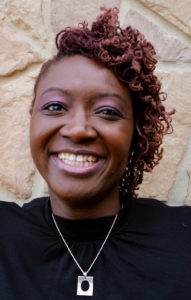
Bukola Landis-Aina
Let’s look at what transpired a year earlier. In 2016, Bukola Landis-Aina, a bisexual Nigerian American woman and board member, created the organization’s first Diversity Advisory Board. This not only led to the name change, but also a re-envisioning of the organization’s “mission, vision, and values to include pursuing anti-racist outcomes and the creation of equity,” according to a statement.
After an interim period, Landis-Aina became the next executive director, and under her leadership the pursuit of “anti-racist outcomes and the creation of equity” has blossomed. With the creation of both an Equity, Diversity and Inclusion Council that “reviews programming to ensure content and presenters are in line” with the aforementioned values and an Events Advisory Council that ensures accessibility of their in-person events regardless of race, ability or finances, Q Christian Fellowship is making good on their promise to “model radical belonging.”
In other words, Q Christian Fellowship took “seriously the struggle of the privileged and powerful to fully grasp” the ways in which they were unintentionally reinforcing white supremacy and potentially alienating persons of color and other marginalized people. Then, after apparently entering into “needed conversations,” the leadership took action.
Landis-Aina’s progression from important, but peripheral, influence as a board member to central leader as the executive director exemplifies Dyer’s shift from “inclusive” to “representative.” And that shift required a reckoning, a reimagining, a redirection — and a resignation.
While the details of Lee’s departure are confidential, he revealed on his blog that the decision left him “crushed” and with “tremendous sorrow.” That’s because with change comes grief.
Blessed are those who mourn
For all those who founded and form the leadership of Wild Goose, releasing the festival to the ownership of the “others” they’ve been trying to welcome and include likely would be a painful and personal loss. Viewing their actions, or lack thereof, through the lens of avoiding grief humanizes them, but it doesn’t excuse them.
Relinquishing power doesn’t come easily for anyone who wields it. But it is unquestionably the way of Christ, who voluntarily gave up his power to become the servant of all in his quest to dismantle the empire’s systems of injustice.
White supremacy is the empire of our day, and as followers of Christ we must dismantle it. Even when, especially when, it costs us our own positions of power. This is the invitation Jesus issued the rich young ruler in Mark 10, and it’s the same one all the powerful and privileged must accept if we are to truly embody the justice of the gospel. Including Wild Goose.
Amy Hayes currently serves a Clemons Fellow with BNG. She is a master of divinity student at Mercer University’s McAfee School of Theology.
Related articles:
I follow Jesus and contribute to racism? Question mark? | Opinion by Jon Singletary
Saving our churches from Dylann Roof’s white Jesus | Opinion by Robert P. Jones
‘God bless white America’: Why we need to overturn white racial mythologies | Opinion by Greg Garrett


